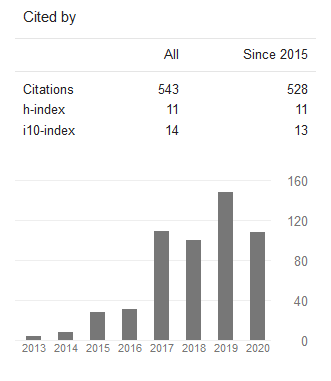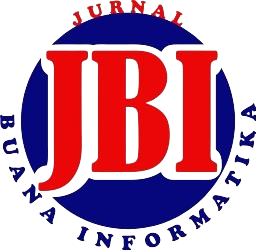Evaluasi Kesiapan Pengguna Dalam Adopsi Sistem Informasi Manajemen SEIP Menggunakan Metode Technology Readiness Index
DOI:
https://doi.org/10.24002/jbi.v8i2.1082Abstract
Abstract.
Information and Communication Technology (ICT) and education are inseparable in this digital era. The basic principle use of ICT is to simplify human life. However, in some places there are still several problems in adopting the ICT. The problems in adopting ICT are human resources, Technical and Finance. Unprepared users will reduce system efficiency that ICT cannot be implemented and utilized optimallyin the operation. The purposes of this research are to measure the level of readiness of prospective technology users in adopting the Management Information Systems (MIS) of Student Entrepreneurial Program and Intership (SEIP) using Technology Readiness Index (TRI) methods and to find a solution so that the adoption of SIM SEIP can be successfully implemented as good result. The results show that two dimensions of optimism and innovation can significantly affect against TR variables. While the other dimensions such as inconvenience and insecurity do not affect significantly against TR variables.
Keywords: Information and Communication Technology, Technology Readiness Index, Management Information Systems
Abstrak.
Teknologi Informasi dan Komunikasi (TIK) dan dunia pendidikan tidak dapat dipisahkan pada era digital seperti saat ini. Prinsip dasar dari penggunaan TIK adalah mempermudah kehidupan manusia. Namun dibeberapa tempat masih sering ditemui beberapa kendala dalam pengadopsian TIK. Kendala yang dihadapi dalam adopsi TIK antara lain adalah sumber daya manusia, teknis dan keuangan. Ketidaksiapan pengguna sedikit banyak akan mengurangi efisiensi sistem sehingga belum bisa diimplementasikan dan dimanfaatkan secara optimal. Tujuan dari penelitian ini adalah mengukur tingkat kesiapan calon pengguna teknologi dalam adopsi Sistem Informasi Manajemen (SIM) Student Enterpreneur and Intership Program (SEIP) menggunakan metode Technology Readiness Index (TRI) dan menemukan solusi agar adopsi SIM SEIP dapat berhasil dan bisa diimplementasikan dengan baik. Hasil penelitian menunjukkan dua dimensi yaitu optimism dan innovativeness berpengaruh secara signifikan terhadap variabel TR. Sedangkan dua dimensi lain yaitu discomfort dan insecurity tidak berpengaruh secara signifikan terhadap variabel TR.
Kata Kunci: Teknologi Informasi dan Komunikasi, Technology Readiness Index, Sistem Informasi Manajemen
References
Aisyah, M. N., Nugroho, M. A., & Sagoro, E. M. (2014). Pengaruh Technology Readiness Terhadap Penerimaan Teknologi Komputer Pada UMKM di Yogyakarta. Economia, 10(2).
Ajzen, I. (1991). The Theory of Planned Behavior, 50, 179–211. Retrieved from https://pdfs.semanticscholar.org/6256/ca4853f44ab9acb98f91f0d7848c54185ca7.pdf
Chin, W. W. (1995). Partial Least Squares is to LISREL as Principal Components Analysis is to Common Factor Analysis. Technology Studies, 2(1995), 315–319.
Chin, W. W. (2010). Bootstrap Cross-Validation Indices for PLS Path Model Assessment. In V. E. Vinzi, J. Henseler, & H. Hwang (Eds.), Handbook of Partial Least Squares: Concepts, Methods and Applications in Marketing and Related Fields (pp. 83–97). Berlin: Spinger. http://doi.org/10.1007/978-3-540-32827-8_4
Chin, W. W., Gopal, A., & Salisbury, W. D. (1997). Advancing the Theory of Adaptive Structuration: The Development of a Scale Measure Faithfulness of Appropriation. Information System Research, 8, 342–367.
Chin, W. W., Marcolin, B. L., & Newted, P. R. (2003). A Partial least Squares Latent Variable Modeling Approach For Measuring Interaction Effects: Results From a Monte Carlo Simulation Study and Voice Mail Emotion/Adoption Study. Proceedings of the Seventeenth International Conference on Information Systems, 21–41. http://doi.org/10.1287/isre.14.2.189.16018
Clason, D. L., & Dormody, T. J. (1994). Analyzing Data Measured by Individual Likert-Type Items. Journal of Agricultural Education, 35(4), 31–35.
Compeau, D. R., & Higgins, C. A. (1991). A Social Cognitive Theory Perspective On Individual Reactions To Computing Technology. In International Conference on Information Systems (ICIS) at AIS Electronic Library (AISeL) (p. 55). Retrieved from https://pdfs.semanticscholar.org/553b/5d2f07e66fb539ca9623414beaa79975a41b.pdf
Cooper, D. R., & Schindler, P. S. (2006). Business Research Methods (9th ed., Vol. 9). New York, NY: Irwin/McGraw-Hill: McGraw-Hill Irwin.
Davis, F. D. (1989). Percieve Usefulness, Percieve Ease of Use, and User Acceptance of Information Technology, 13(3), 319–340.
Dewanta, V. (2012). Peranan TIK Dalam Mengubah Kultur Belajar Mahasiswa. Dompu. Retrieved from http://www.academia.edu/3671032/Peranan_TIK_Dalam_Mengubah_Kultur_Belajar_Mahasiswa
Dishaw, M. T., Strong, D. M., & Bandy, D. B. (2002). Extending The Task-Technology FIT Model With Self-Efficacy Constructs. Eighth Americas Conference on Information Systems, 1–7.
Efron, B., Rogosa, D., & Tibshirani. (2004). Resampling Methods of Estimation (In N.J. Sm). New York, NY: Elsevier: International Encyclopedia of the Social & Behavioral Sciences.
Florestiyanto, M. Y. (2013). Evaluasi Kesiapan Pengguna Dalam Adopsi Sistem Informasi Terintegrasi di Bidang Keuangan Menggunakan Metode Technology Readiness Index. Seminar Nasional Informatika UPN ”Veteran” Yogyakarta, (1979–2328), 288–296.
Gay, L. R., & Diehl L., P. (1992). Research Methods for Business and Management. New York, USA: Macmillan Publishing Company.
Ghozali, I., & Fuad. (2008). Structural Equation Modeling: Teori, Konsep, Dan Aplikasi Dengan Program Lisrel 8.80 (2nd ed.). Semarang: Badan Penerbit Universitas Diponegoro Semarang.
Ghozali, I., & Latan, H. (2015). Partial Least Squares Konsep, Teknik dan Aplikasi Menggunakan Program SmartPLS 3.0. (Dedi, Ed.) (2nd ed.). Semarang: Badan Penerbit - UNDIP.
Hair, J. F., Black, B., Babin, B., Anderson, R. E., & Tatham, R. L. (2006). Multivariate Data Analysis (6th ed.). New York: Prentice Hall.
Hair, J. F., Ringle, C. M., & Sarstedt, M. (2011). PLS-SEM: Indeed a Silver Bullet. The Journal of Marketing Theory and Practice, 19(2), 139–152. http://doi.org/10.2753/MTP1069-6679190202
Hartono, J. (2008a). Metodologi Penelitian Sistem Informasi. Yogyakarta: Andi Offset.
Hartono, J. (2008b). Pedoman Survei Kuesioner: Mengembangkan Kuesioner, Mengatasi Bias dan Meningkatkan Respon. Yogyakarta: Andi Offset.
Hartono, J. (2011). Konsep dan Aplikasi Structural Equation Modeling (SEM) Berbasis Varian dalam Penelitian Bisnis. Yogyakarta: Unit Penerbit dan Percetakan STIM YKPN.
Henseler, J., Ringle, C. M., & Sinkovics, R. R. (2009). The Use of Partial Least Squares Path Modeling in International Marketing. (R. R. Sinkovics & P. N. Ghauri, Eds.) (Advances i, Vol. 20). Emerald Group Publishing Limited.
Hermana, B. (2007). Model Adopsi Teknologi Informasi. Retrieved February 17, 2017, from http://nustaffsite.gunadarma.ac.id/blog/bhermana/2007/06/07/model-adopsi-teknologi-informasi/
Indriantoro, & Supomo. (2002). Metodologi Penelitian Bisnis untuk Akuntansi dan Manajemen (Pertama, Vol. 1). Yogyakarta: BPFE-Yogyakarta.
Jerold L. Hale, Brian J. Householder, & Kathryn L. Greene. (2014). The Theory of Reasoned Action. Retrieved from http://eclipse.rutgers.edu/wp-content/uploads/sites/51/2014/pdf/TRAbkch-02.pdf
Likert, R. (1932). A Technique for The Measurement of Attitudes. New York: Archives of Psychology.
Ling, L. M., & Moi, C. M. (2007). Professional Students Technology Readiness, Prior Computing Experience and Acceptance of an E-Learning System. Malaysian Accounting Review, 6(1), 19–44.
Nerkar, A., & Shane, S. (2002). Determinants of Technology Commercialization: an Empirical Examination of Academically Sourced Inventions.
Pambudi, S. A. (2015). Analisis Kesiapan Pengguna Sistem Informasi Akademik. Seminar Nasional Teknologi Informasi Dan Multimedia.
Parasuraman, A. (2000). Technology Readiness Index (Tri): A Multiple-Item Scale to Measure Readiness to Embrace New Technologies. Journal of Service Research, 2(4), 307–320. http://doi.org/10.1177/109467050024001
Parasuraman, A., & Colby, C. L. (2002). Techno‐Ready Marketing: How and Why Your Customers Adopt Technology. Journal of Consumer Marketing, 19(4), 359–361.
Perdana, A. (2011). Isomorfisma Dalam Adopsi Teknologi Informasi Pada. SNATI (Seminar Nasional Aplikasi Teknologi Informasi), 2011(Snati), 17–18.
Prabowo, D. C., Winarno, W. W., & Fauziati, S. (2014). Analisa Kesiapan Individu Dalam Mengadopsi Sistem Informasi Manajemen Kepegawaian (SIMPEG) Studi Kasus Pada Pemerintah Kabupaten Wonosobo. Seminar Nasional Teknologi Informasi Dan Multimedia.
Rachmawati, I. (2008). Kajian Mengenai Kesesuaian Technology-Readiness Index (TRI) Dalam Konteks Yang Berbeda. Academia.edu, 1–11. Retrieved from https://www.academia.edu/12074499/Kajian_Mengenai_Kesesuaian_Technology-Readiness_Index_TRI_Dalam_Konteks_Yang_Berbeda
Rockbridge Associates, I. (2014). Technology Readiness Index Primer. Retrieved from https://rockresearch.com/technology-readiness-index-primer/
Salisbury, W. D., Chin, W. W., Gopal, A., & Newsted, P. R. (2002). Research Report: Better Theory Through Measurement-Developing a Scale to Capture Consensus on Appropriation. Information System Research, 13, 91–103.
Sanusi, A. (2011). Metode Penelitian Bisnis. Jakarta: Salemba Empat.
Sugiyono. (2008). Metode Penelitian Kuantitatif Kualitatif dan R&D. Bandung: Alfabeta.
Tim SEIP. (2015). Laporan Kegiatan SEIP. Yogyakarta.
Umar, H. (2005). Riset Sumber Daya Manusia dalam Organisasi. Jakarta: PT Gramedia Pustaka Utama.
Venkatesh, V., Moris, M. G., Davis, G. B., & Davis, F. D. (2003). User Acceptance of Information Technology: Toward a Unified View. MIS Quarterly, 27(3), 425–478. http://doi.org/10.2307/30036540
Wiyono, A. S., Ancok, D., & Hartono, J. (2008). Aspek Psikologis pada Implementasi Sistem Teknologi Informasi. In Konferensi dan Temu Nasional Teknologi Informasi dan Komunikasi untuk Indonesia. Jakarta.
Yuliansyah, F. D., Dwiangga, M. R., Pramudito, P., & Pratama, B. Y. (2014). Laporan Akhir SIM SEIP. Yogyakarta.
Downloads
Published
Issue
Section
License
Copyright of this journal is assigned to Jurnal Buana Informatika as the journal publisher by the knowledge of author, whilst the moral right of the publication belongs to author. Every printed and electronic publications are open access for educational purposes, research, and library. The editorial board is not responsible for copyright violation to the other than them aims mentioned before. The reproduction of any part of this journal (printed or online) will be allowed only with a written permission from Jurnal Buana Informatika.
This work is licensed under a Creative Commons Attribution-ShareAlike 4.0 International License.









